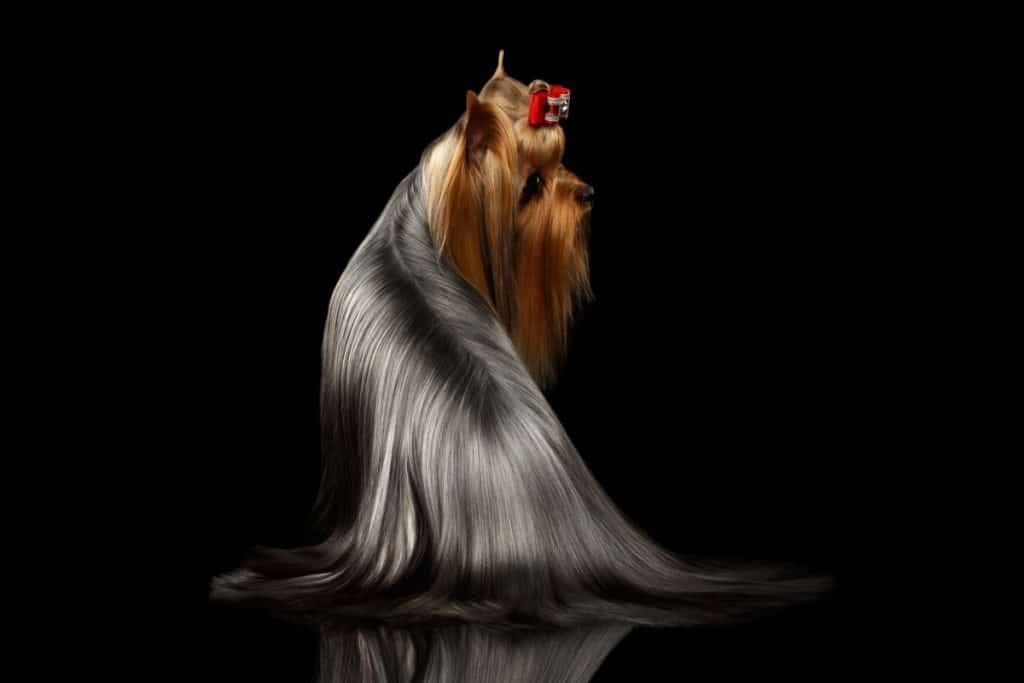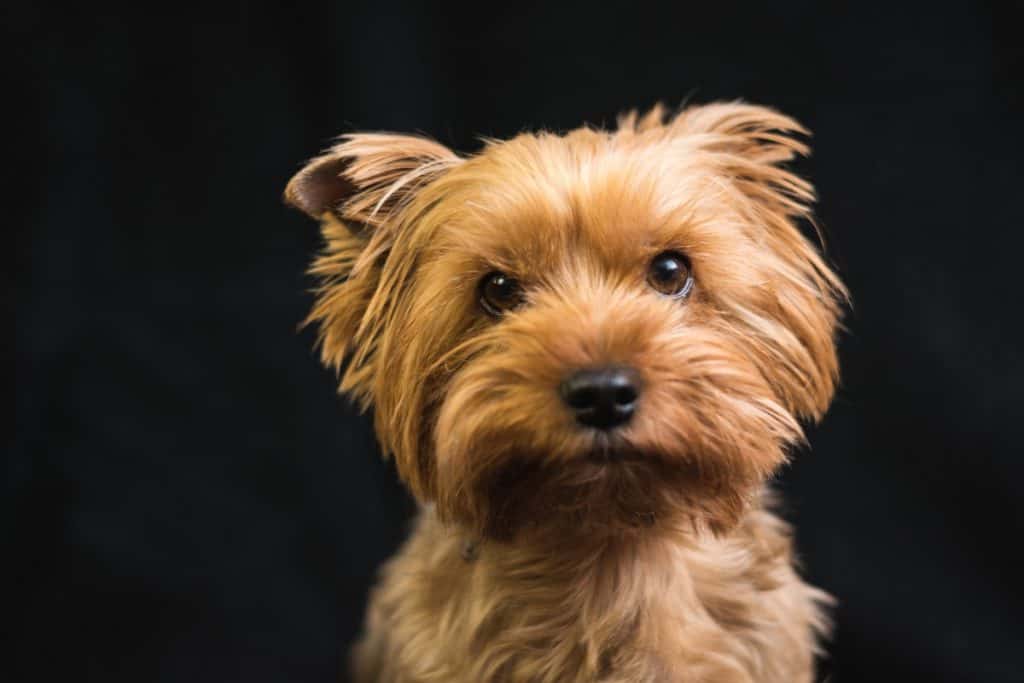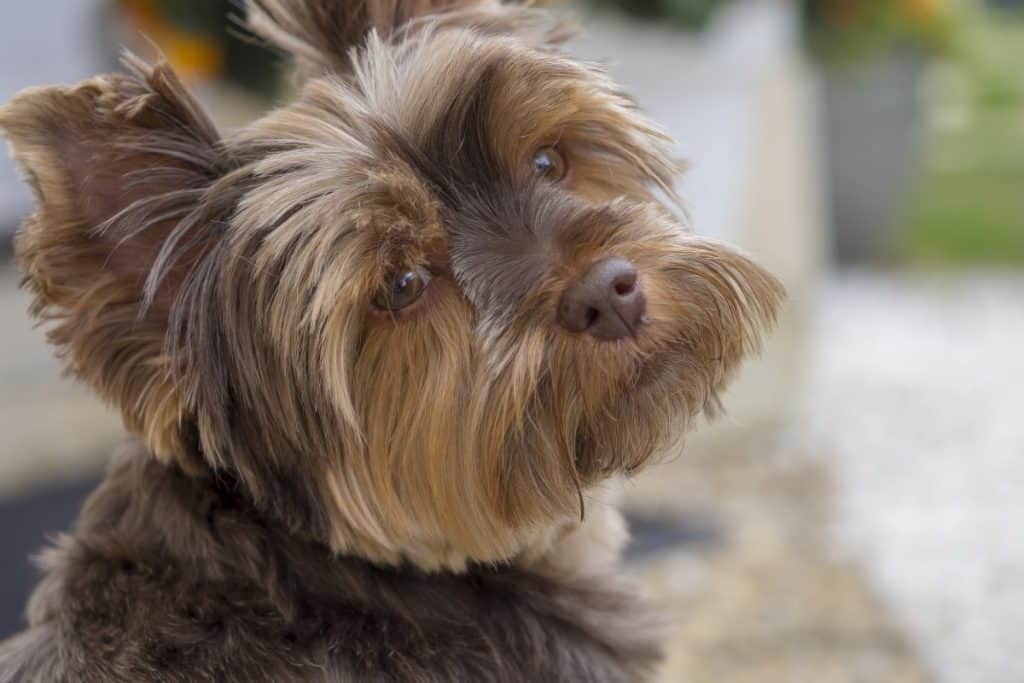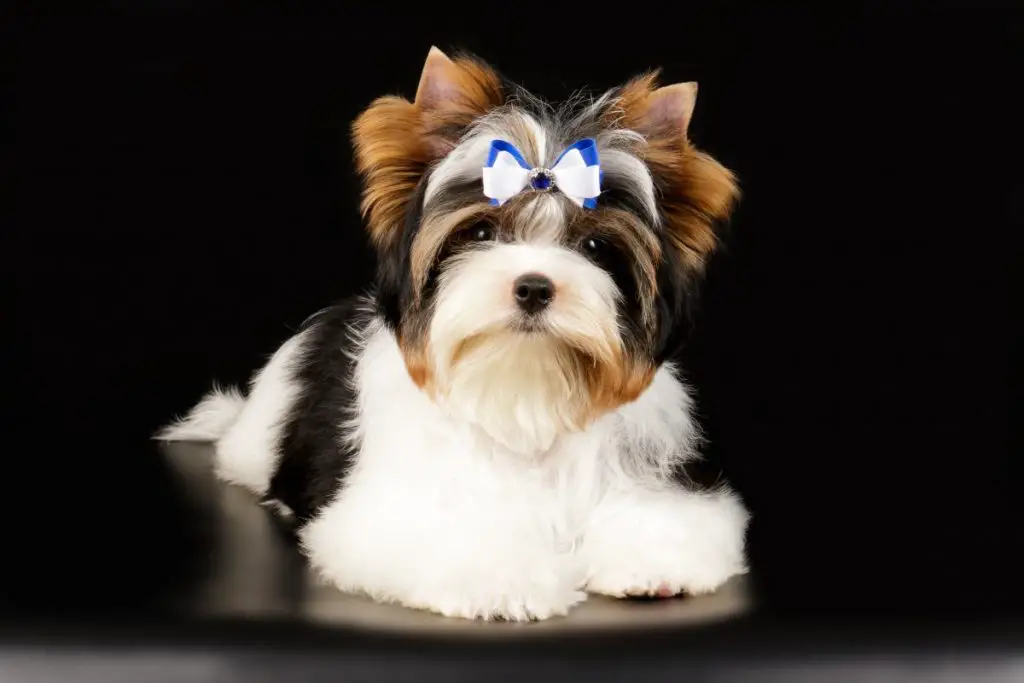Affiliate Disclosure: This post may contain affiliate links. If you make a purchase after clicking on these links I will be compensated at no extra cost to you. However, I never recommend anything I don’t love or wouldn’t use myself!
Yorkshire Terriers are awesome little dogs with big personalities. They typically have a fairly distinctive black and tan color (sometimes referred to as blue and gold or blonde). However, there are exceptions to the standard coloration including fully gold or blonde, but you don’t see them around too often. So…
Are golden Yorkies rare? Pure blonde/golden Yorkies are extremely rare, as is any solid colored Yorkie. Over 99% of traditional Yorkie puppies are born with both black and tan in their coat.
A rare coloration is exciting to see in a Yorkie; however, it can make or break a dog’s outlook depending on who you ask. We’ll talk about why a blonde Yorkie is so rare, what the breeding foundation and others think about these blondies along with potential health issues.
What Makes A Golden Yorkie So Rare?
One of the main reasons why blonde Yorkies are so rare is that the traditional Yorkie breed has had a strict coloration that has been bred into them going all the way back to the 1800s. This is why they have such a unique appearance that is so easily recognized.
Hallmarks of a Traditional Yorkie

Traditional Yorkie puppies are almost always born a mixture of tan and black. As they mature their black hair loses pigmentation and morphs into a mixture of black and gray.
This is what gives the Yorkies saddle a “blue” or “steel-blue” appearance. It may take anywhere from around 6 months to 3 years for Yorkies to fully transition to their adult coloration.
As a Yorkies’ hair gets longer, the tanned portion of their coat also tends to appear a little lighter, often giving them more of a golden or blonde look. This is why fully tan Yorkies are often referred to as golden or blonde.
Breeders Do Not Seek to Breed Solid Colored Yorkies
Reputable breeders generally look for breeding pairs with ideal color in order to achieve the standard and traditional Yorkie color combination. Solid blonde Yorkies (and other solid colors) do not conform to the AKC’s traditional Yorkie breed standards.
When it comes to dog shows, a pure blonde Yorkie which is commonly referred to amongst show breeders as “running gold” is seen as a fault. As a result, they are not eligible to compete.
Breeding these purely blonde dogs is also not recommended by people in the industry for different reasons, here’s a couple:
- If enough people were to breed non-standard colors frequently enough, the unique and iconic Yorkie coloration could begin to disappear and may vanish forever.
- There are potential health risks associated with breeding dogs specifically for color.
So if you are looking for a solid blonde/golden Yorkie puppy, the odds are not in your favor. They are extremely hard to come by.
Why Do Golden Yorkies Exhist Then?

A true golden Yorkie that is actually born totally gold is incredibly uncommon. Those that are born this way are said to have a certain recessive gene that comes with its own health issues. I haven’t personally seen any evidence or detailed information on these health issues (believe me I’ve looked). Nevertheless, many enthusiasts say that these dogs should categorically not be bred.
Alternatively, though still uncommon, purebred Yorkies can be born with an improper saddle pattern and so very little black/blue can be seen in their coat. These are healthy dogs that only appear to be mostly or fully golden or blonde.
These solid colored dogs are still not eligible for dog shows and they also shouldn’t be bred to conserve the traditional breed coloration. However, they may still be recognized and registered with the AKC if both parents are traditional purebreds.
What Do People Think Of Golden Yorkies?
While most of the population certainly wouldn’t turn their nose up at a blonde or golden Yorkie, their status among dog breeders and experts in the community is not always so golden.
- Revered Yorkie breeders actually recommend people stay away from solid colored Yorkies. They say some breeders purely breed them for color and maybe doing so unsafely. There have been cases of breeders scamming less experienced owners into paying over the odds for these “rare” color types. At the same time, they may not have been bred to the same high standards and may even have underlying health issues.
- Blonde puppies may be pushed off faster than their correctly colored brethren. Since breeders are looking for specific coat types and colors when breeding to meet AKC standards, puppies that don’t meet these criteria often will be the first to go. Breeders may try to sell them as quickly as they can or even turn them into their local shelters so that their own reputation isn’t brought into question.
- Solid colored Yorkies aren’t allowed to compete in dog shows. As previously mentioned, any dog straying from the standard Yorkie colors cannot compete. While they may still be considered Yorkshire terriers, the Board does not want the specifications for breeding to change with the addition of solid-colored dogs.
Despite the bad rap that golden Yorkies have among specialists, they still deserve to be loved. Regardless of color, a blonde Yorkie is just as lovable as their colored counterparts. So, if you aren’t concerned about breeding or competing in the AKC, then a golden or blonde Yorkie can be a valuable addition to your home.
Health Risks When Breeding Blonde Yorkies
Various colors are made up of different mixes of dominant and recessive genes. While coat color may not seem like a big deal to the general public, well-versed breeders work very hard to breed them correctly.
Breeders who only breed to achieve that blonde color may not factor in other health issues. If breeders are only concerned about getting one solid color, they may keep breeding or even inbreed their dogs to get that gene to express. This can lead to health conditions like heart problems, joint pain or other issues in the process.
Yorkies That Look Blonde, but Actually Aren’t…
As I touched upon at the beginning of this article, one of the unique features in Yorkies is that their color changes as they age. This is because they possess a special graying gene that affects the production of eumelanin which is the black pigment in both their skin and hair.
Interestingly, some Yorkies have two copies of this graying gene, resulting in an even lighter appearance as they mature.
As Yorkies’ hair becomes lighter with age they can have a deceptively blonde appearance. This is particularly true for Yorkies who don’t have so much dark hair from the beginning.
The following clip is a good representation of how Yorkies change color as they grow.
Sometimes, Yorkies will appear more blonde/golden than they actually are purely thanks to the viewer’s perspective.
As it’s normal for Yorkies to have a lighter face and legs, if you see a portrait-style picture of one, it can appear to be fully blonde when in actual fact the black portion of their body is just hidden.
Another point that ties into this is that Yorkies have many hairstyles. Some styles can make them appear lighter than others. When the darker hair on their body is kept shorter in relation to the rest of them they can also appear to be more blonde than they actually are.
What If I See a Blonde Yorkie and Want to Adopt?
If you are going to adopt a blonde Yorkie (or any rare colored Yorkie for that matter), you should try your best to ensure the breeder has bred them responsibly. Don’t fall for the color craze!
Check the breeder’s paperwork on the puppy. Sometimes, breeders may breed in the blonde color from a lab or golden retriever, thus making the puppy no longer a pure-bred Yorkshire terrier. You should also request to see the dog’s BAER test results to rule out deafness as a result of poor breeding practices.
By all means, if you see a rare colored Yorkie at your local shelter, feel free to adopt it. However, if you are paying a breeder that’s charging more than for the dog’s standard colored siblings, run! This breeder is probably just trying to make a quick profit.
Any breeders who are getting paid extra for these “rare” Yorkie puppies are more likely to try and breed more of them in the future. This encourages unsafe breeding and can introduce defects in the gene pool. Don’t feed into it! It’s also worth remembering that if enough people did this, it could eventually spell the end for the traditional Yorkie as we know it.
Check the entire dog for other colors. As mentioned, while still rare, it’s normal for a Yorkie to be primarily tan with smaller than average black portions in their coats. If you find subtle multi-coloring, it’s more likely that you have a healthy dog. This may not be as apparent in photos or videos. Go see the dog in person and check for subtle colorings that could be hidden or less visible at first glance.
Other Yorkie Colors
You may have seen or heard of some other Yorkie colors around. These include the following:
Chocolate Yorkies

The origin of chocolate Yorkies is unknown but many believe it is the result of crossbreeding with another breed such as a Dachshund.
Chocolate Yorkies are actually born completely brown. They also have distinctively brown nose and eyes compared to the standard darker color seen in other Yorkies.
They can be registered with the AKC but are not permitted in dog shows.
Red-Legged Yorkies
Red-legged Yorkies come to being when two copies of a specific recessive gene are found in both of the parents. They often have what is referred to as the “throwback gene”. These dogs will commonly have inherited physical traits from as far back as five generations.
Red-legged Yorkies do not undergo the aforementioned graying effect so their black hair remains the same color into adulthood. Additionally, their standard tan-colored hair develops into a shiny deep reddish color as they mature.
Again, these dogs can be registered with the AKC but are not permitted in dog shows.
Parti Yorkies & Biewer Terriers
Parti Yorkies were once viewed as poor quality Yorkies with many believing they were a genetic leftover resulting from cross-breeding. However, as of the year 2000, they were officially recognized by the AKC as a purebred Yorkie due to results from genetic testing.
Typically these dogs display significant portions of white with black and/or tan. There are some less common variants such as the chocolate parti and the golden parti which are white and chocolate or white and gold respectively.
Parti Yorkies are easily confused with Biewer Terriers which are actually a completely separate breed although they can look almost identical. The difference is that the Biewer Terrier possesses the piebald gene which is usually not found in Yorkies. They originate from Germany thanks to a couple named Mr. and Mrs. Biewer who had a large and successful breeding program in the 1970s and 80s.

Black Yorkies
In almost all cases, black Yorkies are actually the result of cross-breeding with other dog breeds. Black Yorkies carry a dominant black gene which also usually results in one of two hair types.
- Dull Hair – The Yorkies’ hair is quite thick and grows fairly rapidly. It lacks the typical glossy shine that most Yorkies display.
- Rigid Hair – The Yorkies’ hair has a rough texture and usually doesn’t grow as long as it should.
To Conclude
Yes, blonde Yorkies are rare but this mainly because their existence is not necessarily a good thing. Rare makes them sound like some kind of exotic treasure to be hunted and found. However, the truth is these dogs are rare because of the potential implications of breeding a solid-colored Yorkie.
Some irresponsible breeders may breed these puppies for their rarity, without care for the consequences.
With this unusual coloring may also come defects and health problems. However, because they are “rare” people can be conned into paying over the odds for them. Be sure to ask questions and thoroughly check out the breeders before investing in one of these dogs.
Nonetheless, all dogs need a home and to be loved, so don’t feel that you can’t give one of these dogs a chance at happiness. Just don’t support irresponsible breeding practices and actively seek these dogs out.

